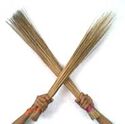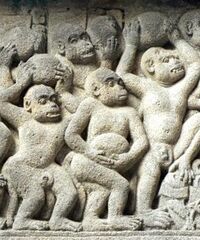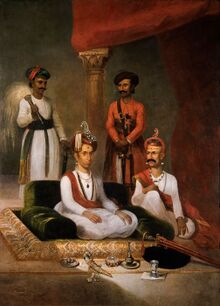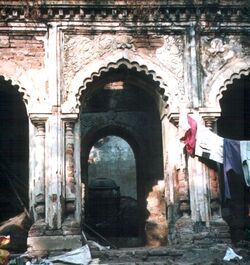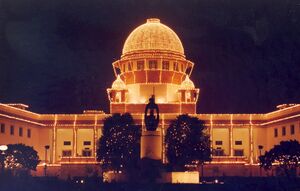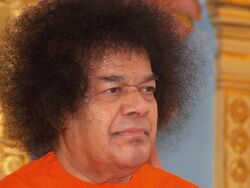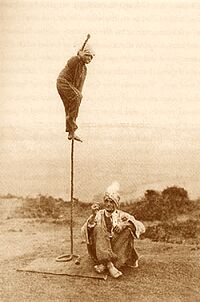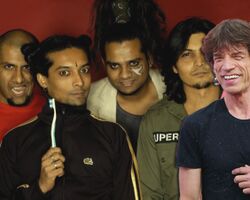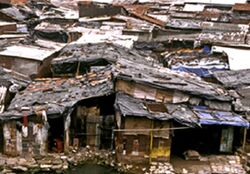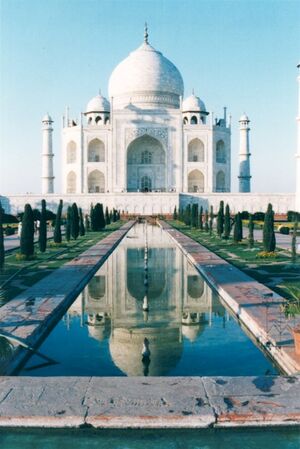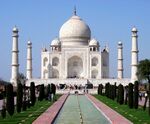India
भारत गणराज्य Bharata-gana-ragya India | |||||
|---|---|---|---|---|---|
| |||||
| Anthem: "Jindabaad" | |||||
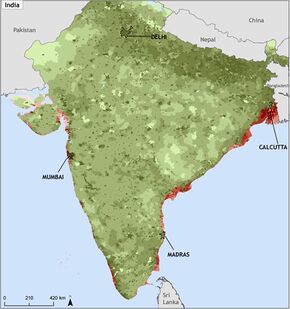 Green is India and red areas are just a bit hotter. | |||||
| Capital | New Delay | ||||
| Official language(s) | Hinglish, Hindi, Urdu, Marathi, Bengali, Sanskrit, plus 7243 colloquial dialects | ||||
| Currency | Rupee | ||||
| Population | |||||
India, the world's biggest democracy, is an Asian mishmash composed of dirt, swamp, sparks, haze, spice, mind, ignorance, enlightenment, bliss, discrimination, curry shits, public indecency and egos all wrapped tightly in the void. It is an ancient conch-shell shaped land-mass surrounded by Pakistan to the West, Bangladesh to the East, China to the North East, Nepal to the North, Sri Lanka to the South, the Bay of Bengal to the West, with the smog below, the dead ancestors above, and which is directly accessible from most anywhere by foot.
With a population estimated at over a Nillion and rising by the millennium, India is the only country in the world where its human occupants outnumber its total population; and which boasts a rash of demigods far exceeding its entire ant colonizations.
With over 80 percent of the population claiming to be some variation of reincarnated Hindu, it is impossible to identify the exact number of people living in India at any given time as Government census forms are routinely filled with not only the participant’s current details, but also the details of their previous lives, or the lack thereof[1].
India’s economy, while essentially a cacophonous orgy of haggling, is currently growing at an exponential rate and possesses the worlds seventh largest Gross Domestic Product (GDP), the third largest Purchase Power Parity (PPP) and the worlds highest rate of Perpetual Overhead Variable Earnings Relegated Truncation * Year (POVERTY).
History
Ancient history
Creation start date: Eternity. In the beginning was the word, and the word was with God, and the word was OM. Using this sexy little symbol the Supreme Being conjured up the material existence in one colossal big bag which resulted in matter infused with spirits and vise versa. Actually it is a bit more complex than that. God sprouted a lotus from his navel and from there sprang forth Brahma, the created creator, the caused cause of all causes. Brahma looked all around and could only see water. So he thought WTF? And proceeded to torture himself so severely that God appeared before him and asked WTF? Brahma told God that he wanted to do his thing, but just plain forgot. With that God cast his casual-glance upon Brahma and thence forth appeared Grade A Soma. Brahma immediately drank some Soma and got so enlightened that he had it all figured out, where upon he created Bharat. As the aeons passed many alien-incarnations appeared to try and talk sense into the dinosaurs, but it wasn't until an alien shagged a dinosaur, whose off-spring in turn impregnated a monkey, that the DNA of man & women appeared from the muck and populated the land - which by then was renamed India by Christopher Columbus[Citation not needed at all; thank you very much].
While many evolutionary scientists believe that human life first started in Africa, NOT! Civilisation first started in India. Being askance of three continents India was the navel of the world, and before the Ancient Greeks started to ask themselves questions about if there was a God, the Indians were partying with them every night. This was where they invented writing, in order to be able to communicate with each other without being on the same cloud, and mathematics, so they could then tell the person they were communicating with how much their score was. In fact ancient India created everything that makes civilisation what it is today, and being at the centre of the world they were also the heart of trade and creation, and probably the first people to realize that wheels work better when they're round instead of boulder-shaped.
Moghal hordes
The Monkey Gods helped the supreme void in one instance for which they were punished with the Moghal invasion in the 16th century. Haggard bands of Islamic nutters went around converting all the monkey men into Muslims, whom they promptly fed to their hungry camels and goats. Those who escaped this gluttonous slaughter became Hindus (the unslaughtered), and they lived hungrily until cow-eating white men came with guns, a central banking system, and diabolical plans such as big telegraph, roads and railways, which culminated in the British Raj[2] The Raj was truly a golden age when everyone was gainfully employed and they all lived under the magnanimous gaze of a real monarch.
British Raj
The British Illuminati, obsessed as they were with a New World Order, saw India and decided they wanted it. Presto! It was theirs for the taking. And the plunder began. This led to poverty among the monkey men which persisted until one bald man took over. The Mahatma said that monkey men must not fight for independence, rather they should strike for independence. His idea was that this would confuse the British, even though they were all employed by the British. The plan worked, and ended up not only confusing the British but even the Indians themselves who got fired from their jobs, leaving them all unemployed, ending up in even greater poverty.
The biggest problem that this bald man did not anticipate was that India, being a subcontinent of billions of everything, would go on to want independence from itself as well. Apparently a common interest in all things curry was not enough to unite a nation or maintain peace with neighboring states. There was only one solution, something that has kept the Indians united and reduced the number of casualties from fighting across the meaningless man-made borders separating village from water source, home from outhouse, and temple from gurudwara. Of course the mystical answer was Bollywood. It doesn't matter what caste, religion, language or culture the modern Indian hails from, absolutely no one with a TV could be bothered fighting when they could tune into the constant stream of low budget cinema being beamed into their cow-dung encrusted slums.
Later, after the population in India exploded, each person was allotted 5 triangle metres of space for eating, sleeping, mating, and fearing. And this led to an interesting fact: previously every 7th person in the world was an Indian, today every 6th person is an Indian, in 10 years every 5th person will be an Indian, and very soon everyone will be an Indian -- with the exception of the Chinese and Polish races, who pose a similar problem to humanity. All three races share this very ingenious idea to attain world domination. But as usual Indians will continue to be conquered many times, mostly by international corporations needing cheap IT and tech support. After all, somebody has to hire them.
Legal system
Based entirely on eternal procrastination, time wasting, bribery and karma, Indian law can best be understood by considering the following true life Indian legal case studies:
Case 1. For the first time in decades the High Court of Goa was re-opened to try the case of the murder and sexual assault of a British teenage girl in India's seaside resort of Goa 42 years ago, attorneys said. Police have charged two Indian men – late Pagala Gupta and Ravi Raj – both deceased, in connection with the February 1968 killing of then 18-year-old Scarlett Keeling in a case that dealt a blow to Goa's hippie paradise image. The suspects, long since dead, have been charged with culpable homicide (which does not amount to murder) and grievous sexual assault. Both denied any wrongdoing according to their testimony given in 1968.
Police officer, Gurunath Naik, son of the officer in charge of the investigation in 1968, also deceased, testified as the first witness, said public prosecutor S.R. Rivankar. Naik said his late father saw Keeling's bruised, partly clothed body on a beach near the shore when he arrived at the scene, Rivankar said. Indian police initially said Keeling had drowned. But her mother, Fiona MacKeown, also deceased, rejected that theory and launched a campaign for a second autopsy that led investigators to determine she was drugged and sexually assaulted before her death. Federal police say, perhaps, one of the suspects drugged the young girl and then sexually assaulted her. She was left on the seashore in the early hours of February 18, 1968 to Die a "natural death", police said.
The trial should last about six years although no more witnesses were expected to testify – “they have all died! Rivankar said. Goa's police insist the tropical tourist hot-spot is safe for hippies, and cite Keeling’s death as proof an exception. The trial has come 42 years after the crime to mollify the British Embassy in nearby Mumbai, after they expressed outrage over the old assault case. If convicted, the two deceased defendants may be sentenced to "samsara-chakra" or the wheel-of-life, without possibility of liberation.
Case 2. Concerns a legal case which has been pending in India for over one billion years, and is finally set to be heard by India’s Supreme Court. The Case, “Death vs. Life” is based on the case of one bad Brahmin named Ajamila, a sinful man, who was set to be taken away by Death (Plaintiff), whose mission was frustrated by Life (Defendant).
Ajamila was raised as a pure Brahmin and had a chaste and beautiful wife. But one day, while he was collecting flowers for worship, he saw a drunken prostitute engaged in kinky sex with a lusty man. Ajamila got a boner; his mind became attached to the prostitute. Consequently he out-bid the poor “John” and took this slut into his home as a Chambermaid. Inevitably, he abandoned his family and went off with the prostitute. Due to his connection with the slut, he lost all his good qualities. He became a thief, a liar, a drunkard, a murderer, and even a potential terrorist. He completely forgot about his original training as a Brahmin, and his whole life was ruined.
Ajamila begot many children through the prostitute; the youngest son whose name was Narayana (‘God’ in Sanskrit) was his favorite. At the end of his life while he was dying Ajamila began to call his son “Narayana!" At that time Death appeared, to take Ajamila. BUT, at the same time, because he had uttered the holy name of “Narayana!”, Life, also arrived there, and forcefully stopped Death from taking Ajamila for punishment. Death was irate! After a brief argument with Life, Death left in a huff. He then filed this case, citing ‘Obstruction of Justice’. As is normal in the Indian legal system the case took over one billion years to reach the Supreme Court, and soon a judgment will be reached within the next several hundred millennium. Nothing and no one can rush Indian justice.
Disease
From a cow's mouth shaped cave high in the Himalayas the ancient cleansing river Ganges flows down through the land of India, picking up diseases along the way. From the very start the river is being polluted by the stool and urine of holy men all the way down to dog eaters. All of whom relieve nature as well as bath for purification in her fragrant waters. This massive sewer-system has acquired so many germs that a full medical dictionary would only name about half of them. And this trend has grown over ions until the present day, when humanity is now faced with the dreaded Indian super bugs, which are even resistant to themselves. People don't just catch these super-germs, the germs are so aggressive that they chase and catch the people.
And among all of these a genetic mutation that makes all types of germs highly obnoxious and resistant to all known antibiotics has been found in Water supplies in New Delhi used by local people for passing stool and urine, and drinking, washing and cooking. The NDB 1 gene, which creates what some experts describe as "super-bug," has spread to normally civilized germs, which now cause dysentery (also known as Delhi-belly), and the evil mutation is circulating freely by clinging to others in the Indian capital of 140 million people. "The inhabitants of New Delhi are continually being exposed to drug-resistant NDB 1-positive bacteria,"[3] A huge number of Indians are consuming the dreaded bacteria on a daily basis, and they even have a curry named after it called the Delhi-belly Biryani.
NDB 1, or New Delhi Belly 1, makes bacteria resistant to all antibiotics, including the most powerful class, called Hemlock. And NDB 1 makes secular bacteria go completely ballistic, with the only known antidote being direct exposure of the infected area to a military-grade flame-thrower. Delhi-belly first emerged in India over three thousand years ago (when New Delhi was known as Old Delhi), and if left unchecked, it could possibly spread across the world, causing a global outbreak of “Delhi-belly.” Recent studies have investigated how common NDB 1-producing bacteria are in community waste seepage—such as latrines, water pools or rivulets in streets—and tap water in urban New Delhi, all of which have tested equal in purity.
The researchers collected 161,271 swabs from seepage water and over 2 public tap water samples from sites within a 1.2-kilometer radius of central New Delhi from October 6-7, 2010. The NDB 1 gene was found in all of the samples. It would be expected that perhaps as many as fifty million people are carrying NDB 1-bacteria as normal intestinal flora in the center of New Delhi alone. Experts say the spread of superbugs like the Delhi-belly gene threatens whole swaths of modern medicine, which cannot be practiced if doctors have no effective cure. Thus the potential for wider parasitizing of NDB 1 has been here for thousands of years and should not be ignored when visiting this holy land and sampling its culinary delights.
Transportation, Horn Honking, Magic Tricks, and Riots
- SEE Noise
Pollution
Pollution may be spelled differently in Sanskrit, but it still means the same thing: The ashes of burned ancestors dating back to the dawn of creation mixed with carbon monoxide expelled from umpteen Ambassador cars and Tata buses = pollution.
Regardless of Calcutta's bragging rights, Delhi is the official capital of pollution. Although recently officials in Delhi have unveiled a radical solution to tackle the increasingly noxious smog hanging over India: a giant public air freshener that scrubs the atmosphere clean. The seventy-ton Pro-life® which costs about 250 million rupees (£70), sucks in 10,000 cubic meters of dirty Air an Hour, subjects it to a filtering process, and then emits clean air back into the dirty air again.
Delhi officials claim that more of the machines will be bought if the current one, installed at one of Delhi’s busiest traffic junctions as part of a pilot project, proves a success. “We will evaluate its efficacy over three hundred years,” P.K. Gupta, health chief of the New Delhi Municipal Council, told Uncyclopedia. “If it works we will buy more.”
According to the government of neighboring Pakistan (a close rival) Delhi is the dirtiest city in the world in terms of the amount of particulate matter in the atmosphere per square centimeter. A brown haze often lingers over the Indian capital — a smudgy cloud linked by analysts to increasing rates of Death by suffocation. Globally, air pollution claims about two million lives a day, according to the World Health Organization, ranking it second only to death caused by dying.
Athletes who competed in Delhi at the Commonwealth Games were advised to arrive in the city at the last possible second, to minimize the risk to their respiratory systems. Those who live there are at risk of breathing progressively dirtier air as India becomes more desperate. By 2030 the number of vehicles on the country’s already congested roads is expected to rise sevenfold to about 900 billion vehicles.
Environmentalists have criticized the Indian Government for not supporting public transport to cut traffic congestion and pollution levels. They have condemned the Government’s support of factories that build small, cheap cars, pointing out that personal vehicles — cars and two-wheelers — use up more than 175% of the road space in Delhi but meet only 0.02 per cent of the city’s commuting demand.
Corruption
In India if you want any one to work for you then you actually have to pay them. Yes, it is quite shocking. Such misbehaviour and naked greed were unthinkable in the non-Indian world. Imagine, in the land of India you actually have to pay to play. What more needs to be said about corruption. Better to stay home and wash your own dishes in India.
Indian Politics
- SEE CHAOS
Religions
India is a land which prides itself in philosophical diversity and raging debates. Many religions coexist in India, the foremost being Hinduism, Jainism, Buddhism, Sikhism, Guru Maharajism, Yogism, Richism, Poorism, Beggarism, and even Terrorism. Although diverse, all these Indian religions have the same problem, e.g. God is dead.
That's right. In India, a land where gods and goddesses have many faces, one deity in particular stands out, viz., Godman or Mangod, Sathya Sai Baba. Although god is currently claimed to be near dead, and the Hindu world has assumed an urgent mood of prayers for his revival, they all failed miserably. Yet his body is still on life support at the Sri Sathya Sai Institute of Holy Medical Sciences hospital located in a pilgrim town within Anantapur district. Sai Baba -- originally admitted with infection, chest congestion, two collapsed lungs, and terminal TB -- continues to be on ventilator support, receiving mouth-to-mouth resuscitation, defibrillation, blood transfusions, open heart massage, and is also on kidney dialysis - all well and good. But the fact is that HE is dead as a door nail.
Millions of anxious Hindu devotees have been pouring in from different parts of the country as news of Sai Baba’s condition spread. Tension gripped India as far away as Delhi when over 160 million rustic devotees tried to enter his hospital room at the same instant following reports that Sai Baba was not responding to treatment. The Indian government has recently imposed prohibitory orders within 1,000 kilometers of the hospital, although prayers are not mandatory by law. Imagine the situation if God's death becomes known. That means that Christ, Allah, Buddha, Vishnu, Jehovah, and even the void would all be gone. Kaput. And that would be a right royal mess. Although it would probably bring world peace -- at least "shanti" in India. Then a fine period of tranquility would last until the next Avatar makes his sublime appearance to lead the world back into the dark ages.
Opposing Philosophies within Hinduism
Amongst the thousands of religions that make up India, Hinduism is the name for them all. In spite of such convoluted diversity, Hinduism may be boiled down to the following philosophical arguments:
- Jnana (Monism - Voidism - or atheism). Jnana is a branch of Hinduism that is opposite of Hinduism in that, though based on the same books, interprets God as being “0” or the anti-god, God not being a person, while the anti-god is a Void. This Voidism is composed entirely of nothing. Therefore it’s so worthless that a bottle of it could only be sold on eBay. Followers of Jnana, founded by George Carlin are considered to be atheists by the rest of the Hindus. Meanwhile the normal Hindu can’t tell the difference. So if the Void is for you then you’re hardly a Hindu. Or are you!? Is it worth fighting and dying for? You bet!
- Yoga (Inbetweenism - flying carpet). Founded by Yogi Bear, Yoga teaches that God is a tiny little leprechaun living in between your eyes and to see him just hand over all your belongings at the head-office and sit down, stick your elbow in your ear, and shut up! If you're good enough you could attain the door-to-door salesman siddhi. It's not worth fighting and dying for! Or is it?
- Bhakti (Dualism or Theism). Bhakti is a branch of Hinduism that is opposite of Hinduism in that, though based on the same books, interprets God as being a person, while the anti-god is a Void. God, viz., Rama, Krishna or Gandhi, lives in Vaikuntha, a place where there are no lawyers or speeding tickets, and you can hang out with God, tell Polish jokes, wash His feet, an stuff. This Vaikuntha is composed entirely of nothing. Therefore it’s so worthless that a bottle of it could only be sold on eBay. Followers of Bhakti, founded by Mel Gibson are considered to be Theists by the rest of the Hindus. Meanwhile the normal Hindu can’t tell the difference. So if Vaikuntha is for you then you’re hardly a non-Hindu. Or are you!? Is it worth fighting and dying for? You bet!
Hinduism in action
Three Hindus, a jnana yogi, a yoga-yogi, and a bhakti yogi, were together in a car crash and all were killed. Poof! They all appeared together at the Feet of Bhagavan. First God asked the jnan-yogi, "So, what do you believe?" The jnani replied, "I believe in your formless Brahman - so-aham!" God said, "Good, come sit on my side!" Then God said to the bhakti yogi, "So, what do you believe?" The Bhakta replied, "I believe in Your eternal service in Nitya-lila Vaikuntha!" God said, "Good, come sit on my other side!" Then God said to the yoga-yogi, "So, what do you believe?" The yogi replied, "I believe you are sitting on my throne."
Karma
Karma is beyond words, except when Alfred E. Neuman is speaking:
“It means every reaction is followed by an unequal and similar action”
Reincarnation
Indians have no doubt what so ever, based on scientific faith, that there is life both before and after death. This is called reincarnation, and results in repeated births, old age, disease, and deaths, eternally, until you achieve sweet nothingness. To give you a better understanding of how this works we will use the Indian method of teaching by myth:
The following is an instance of reincarnation at work. Rolling Stones front man Mick Jagger has sung in Sanskrit on a new album by a super group he formed in Mumbai which stars a number of deceased rock stars who were all reborn in India. Jagger sings “Arthameva Jayate” (Money Rules), the second single from the group called “Super Heavy.” The super group also features Brian Jones on guitar (reborn as Amar Gupta, a Rickshaw puller in Calcutta), Keith Moon on tablas (reborn as Shantaram Sobha, an indentured eunuch in an obscure Rajasthan village), Metallica's Cliff Burton on bass (reborn as Rajesh Singh, a barley farmer’s son from Punjab), and Eddie Cochran on lead guitar (reborn as Satish Sharma, a Hindu priest who ran away from some temple near Agra).
Arthameva Jayate is the band's second single. The first was named simply, “Chello” or Get Lost. Super Heavy's first album is expected to be released in September. And is rumored to be called, “Mera Dhaani Honey” (My rich baby). Mick said of Jones, "we want his rhythm playing in this album... we want this to be a great piece of exoteric hedonism – and a commercial song too. A long dream for me to raise one of the principles of Indian culture which is Arthameva Jayate (money rules!) and get richer by making it as a song,” Jagger was quoted as saying by the Press Trust of India. “This is historic... it is iconic in a way.” he said. Jagger formed the band in May, saying that he wanted a convergence of different dead musicians styles. “It's different from anything else I've ever been involved in,” Jagger said.
Philosophy
- SEE Bhagavad-gita
Caste System
When not being discriminated by any foreign power, the caste system exists which allows the Indian populace to discriminate against each other. This is called Varna-dharma or the shit-list. People in India are classified as either a godman (Brahmin), a bully (Kshatriya), a conman (Vaisya), or a dirt bag (Sudra). And this is NOT based on birth-right. It is based solely on manifest qualities or lack thereof, viz., birth-wrong.
Recreation
- SEE KAMA SUTRA FOR "R" RATED VERSION
- SEE Tantra FOR "X" RATED VERSION
Humor
Humor, although non-existent in India, never-the-less does exist there in abundance. And rather than bore you with a dry list of genres, a couple example Indian jokes should suffice to establish that India is no laughing matter:
- Once upon a time a poor Indian farmer in Bihar was trying to grow chickens. The fellow planted eggs and watered them day after day but all to no avail. So the farmer went to the government office to complain. After meeting with one Indian bureaucrat and telling his story he was advised that nothing could be done without a proper soil sample.
- There was a new train imported from Germany into India. It was modern and even had a mirror in the toilet which covered the wall. During the first trip some passengers had to pass urine, but when they went to the toilet they saw there was some one inside. Each person saw them self in the mirror and thinking the toilet occupied returned to take their seat. Always there was someone in the toilet so no one could use it. The situation was very bad and the people were angry. When the train reached Amritsar station the angry passengers approached the station master and complained, “Some black-heart is not vacating the toilet!” So the station master marched the people over to see what was the problem. He opened the toilet and looked in, then sheepishly turned to the crowed and informed them, “Very sorry! It is big railway official.”
Wife burning and offering Mother-in-laws into a Volcano
In most of India, husbands regard sacrificial virgins and their mothers as property that apparently can be offered into a Volcano at will. Indian Police say that every year they receive more than 2,500 reports of Sacrificial-virgins-in-volcano -- a form of ritualistic abuse often disguised as an accident or suicide. These Sacrificial females are offered into live volcanoes for "wealth" – usually because their husbands or in-laws are unhappy with the size of the dowry that accompanied them into the marriage. And, perhaps in an attempt to please God into giving them more. The number of such cases reported to police are rising, due either to an increase in the number of virgin offerings or to more willingness by witnesses to report them. And should the woman survive, the toll is heavy.
For example, three years ago, Sunita Bhargava was newly married and was emotionally abused by her husband and mother-in-law. Her mother-in-law used to say that her husband was too spiritual for her, so the distraught husband tried to heave them both into a volcano. Desperate and in pain, she managed to pull herself free and get help with burns on 40 percent of her body. Her mother-in-law was not quite so lucky and was consumed by the fire god. Bhargava now lives alone in a New Delhi slum.
Volcanoes are used by people who do this kind of religious sacrifice because they think it will not leave any evidence behind. Whereas if you use a knife, and offer their hearts to the goddess, there is evidence that someone else has done it. The practice is unlikely to end soon, however, as long as the current Hindu attitude about the place of the sacrificial volcano in religious ceremonies prevails.
In the defense of Indian people it should be pointed out here that Vesuvius was in Italy, and the people of Pompeii never did this kind of sacrifice.[4]
Dope
- SEE Soma
Sports
Possibly the most popular sport in India is the famous, "Train Riding", its something like the mechanical rodeo bull, but more dangerous. It's a tradition since trains ever appeared there, the game consists in holding on the top of the train as long as you can. This attracts many tourists, as you can buy easily a ticket on the train interior to see the game, since almost everyone prefers to see the action from the outside.
The game of Rioting was a joint venture between India and Pakistan. The tradition now is that once any cricket match is over, everyone must riot and burn down a stand. This also keeps the youths in the country employed.
Pakistan is India's long time rival in both cricket & rioting. If you ask an Indian they have won all games; if you ask a Pakistani India have lost all games. The captain of a losing Indian cricket team is sacrificed to a Hindu God of public's choice. The case in a way is different for a winning captain. He would be allowed the privilege of choosing the God to be sacrificed to.
The Indian Football team is in contention with Brazil and England, to win the next Football World Cup, with the master striker, Bhaichung Bhutia expected to come out of retirement any moment. Bhutia is regarded as the God of Football in India. He was the star player for England's top team, Bury F.C., and he got thrown out after one season for undiagnosable reasons. He almost beat Ronaldo to the Balloon D'Orc, the award for being the most over hyped, out of fashion, overpaid footballer. India is also known for its football players rank unbelievably 160 out of some 180 nations.
Food
Indians eat spice. They drink spice, smoke spice, sweat spice, fart spice, and even shit spice. Sometimes if you order it specially you can get food intermixed with all these spices, but you must insist on it while ordering in public restaurants.
Indian food comes in two different dishes, basically containing the same ingredients, curry, and matter. Combined with the 2,375 different flavours of spice though, an Indian dinner can be combined in 10 ^ 87 different ways, giving more tastes than there are taste buds in the mouth. This makes all Indian food end up in tasting unusually spicy, since what the taste buds can detect are basically nuked by all the manifold sensations attacking them.
Although varied in taste still actual Indian food may be divided into only a few categories, viz., Dall (lentils with small rocks), Chappati (bread with small rocks), Bhaat (rice with small rocks), Subji (vegetable with small rocks), Achar (pickles with small rocks), and Meetai (sweets with small rocks). In India selling small rocks can be highly lucrative.
Economy
As you can't write or do mathematics without something to write with, the primary export of India is ink, which is produced in massive quantities by the Indian held megacorporation India Inc.[5] for worldwide export. This makes India one of the world's most powerful countries -- if Indians wanted, they could render all printers obsolete.
Some profane minds that fancy eating beef have conjectured elsewhere that the reason behind the phenomenal explosion of the cow population in India is because Indians do not eat cows. That's like saying that the reason behind the exponential growth of humans in India is because cows do not eat humans; or are too busy taking calls from mindless, frustrated Americans; or too busy building the digital cow milking machine for future generations who are too busy breathing in and out.
A large part of the Indian economy is dependent on Mumbai and Bollywood. It is also dependent on a small workers, otherwise known as children in other parts of the world. All volunteer to leave boring school to work 24/7 to supply clothes to rich people who only buy designer garments with the label 'Hand Woven' on them.
Although there are talks of changing the national language to Java, the HRD Ministry of India believes that C++ would be a better choice. Currently, talks[6] are occurring all over India to resolve this issue peacefully.
It has also been suggested that India is more of a mindset or hologram than a real place. Which means that I never wrote this -- you just imagined you read it. It also means that I never came here: you imagined I did. That, by the way, is also the Indian Economy's infamous "Hindu Rate of Great Indian Rope Trick" (the Chinese trick is worse - It's nothing more than a spoof).
Indians are so proud of the creations of communication at a distance and modes of travel that the highest honour in Indian society is to work in a field where you transport people or communicate to them remotely, making the dream jobs in India today working in a contact centre or driving a taxi. India's main contributions to world economy are outsourcing and inventing 0.
Bollywood
Not satisfied with merely inventing writing and mathematics, Indians took their combined love of communication, their numerous Gods and their love lives, and their love of partying, and creating the most powerful art form that exists today: Bollywood movies.
Bollywood is a very popular film industry and is as popular as Hollywood and is known all over India. They make the worst films in the world. A film is released every 15 minutes. There are no topics in Bollywod movies except for stupid love stories in which uncultured, undisciplined actresses dance shaking their 50 inch booties to the hollow tint of prerecorded music, replete with the sounds of gunfire.
Virtually everyone watches them, including lesbian high school girls and over-sized, middle-aged, old-age housewives. The primary reason for the continuation of the boom in the cinema industry in India is that it's cheaper to pay to sleep in the cool confines of a cinema hall than to pay to crash in a hotel for up to Rs. 3.
Bollywood is also a pastime for Indians. It was invented by Reena Malhotra, a woman who was born with elephantiasis in Kolkata and who sold postcards in Mumbai. It is believed that she asked her rich uncle for a loan on her 18th birthday and got enrolled in an Academy for Visual Arts. Somehow she learned something there to someway return to Mumbai to sometime start Bollywood. All the rest is fiction.
According to a famous film critic, who says this on the condition of anonymity fearing murder, until recently Bollywood denied the existence of sex. Any and every intimate scene, if ever it passed the censor boards, was depicted by two flowers rubbing against each other with their private areas blurred out. The censored rape scenes involved thunder and lightning or huge tidal waves hitting the rocks.
The unofficial reason was to go back to the good old days of blind Shakespeare where every act in a play was left to the imagination of the audience. Then, stalwarts like Rekka Sawat came onto the screen and rediscovered the "dare to bare" philosophy. Of late, explicit scenes have become the norm, so much so that the censor board is contemplating including belly-porn in its archives.
References
- ↑ This problem is more complicated when the person in question is alive in their current life, but weren't in a previous one
- ↑ The Indians were under the misunderstanding that all British men were called Reg or Reggie (as in Reginald). This changed into 'Raj' over the years.
- ↑ Dr. Mark Toeman of Britain's Cardiff University School of Medicine
- ↑ Yeah, now you're thinking about it!
- ↑ Always printed in bold. What's the point in having the world's largest supply of ink if you don't use it?
- ↑ Riots
See also
| Featured version: 23 April 2012 | |
| This article has been featured on the main page. — You can vote for or nominate your favourite articles at Uncyclopedia:VFH. | |
| ||||||||||||||||||||
| ||||||||||||||||||||||||||||||||

